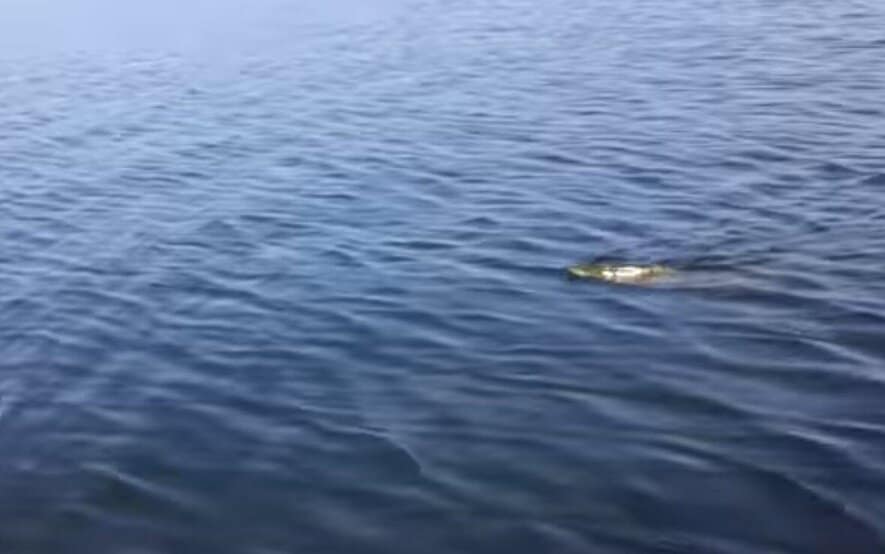Northern pike and other fish in the Esox family like Muskies and Pickerel don’t regularly swim with their heads out of the water, but this is something that you may see if you spend enough time out on the water.
Northern pike and muskies swim with their heads out of the water to soak up additional oxygen, clean debris from their gills, and stabilize their bladder to swim more effectively in deeper water.
While it looks strange, this behavior actually isn’t all that uncommon. It is worth noting that since this is oxygen related, it is possible that this activity will become more common in water where oxygen levels or dropping, possibly indicating a water issue from pollution or other sources, but don’t dump to conclusions as this could just be some big fish looking to dive to where the better meals are.

If you ever see this action there could be several reasons behind it, and we’re going into what’s known, believed, and some first-person angler observations on what it means for fishermen in the area who may see this phenomenon.
Why Do Pike Swim with Their Head Out of the Water?
There are 3-4 main reasons why you might catch a pike, a muskie, or a tiger muskie swimming with their heads out of the water.
The main culprits:
- The fish wants to get more oxygen in its system quickly
- The pike or muskie wants to clean debris (or even parasites) from themselves
- The pike want to stabilize their swim bladder before swimming in deeper waters
- Polluted water (which re-visits the “to get more oxygen” reason)
This is, of course, assuming the pike is swimming casually with their heads or mouths at least partially above water. In circumstances where they are trying to throw the hook from a lure or jump out of the water to avoid a predator (some pretty crazy YouTube videos of pike even shoring themselves to avoid a larger pike trying to eat them), it’s pretty obvious why they are breaking the surface of the water.
It’s also worth noting that this behavior does appear a bit more often in the spring shortly after ice break, at least according to many anglers I’ve talked to in pike country.
Do Muskies Also Swim with Their Heads Out of the Water?
Muskies swim out of the water for the same reasons that pike do. This isn’t surprising considering they’re both big freshwater predator fish who love to ambush their meals and both come from the Esox family, making them very closely related.
This means that if you see a muskie (or tiger muskie) swimming with its head out water it’s because it’s looking to get more oxygen into its system, clean debris or parasites off themselves, or stabilize their swim bladder before swimming into much deeper waters.
This is seen a little bit less often just because there are a lot less muskies swimming around than northern pike. However, these closely related fish are going to do a lot of similar things, and swimming with their heads out of water is no different.
Why Do Tiger Muskies Swim with Their Heads Out of the Water?
While there isn’t any scientific evidence on the matter, there seems to be anecdotal evidence from various far north fishermen that tiger muskies seem to be seen swimming with their eyes or heads out of the water a little bit more often than muskies or northern pike. There isn’t a good or logical reason to explain why this would be the case, and to be honest we’re not even sure that it is – but it’s just one of those oddities that multiple anglers have anecdotally reported from lakes that have pike, muskie, and tiger muskie in them.
There’s no reason these should act that much differently from their pike and muskie parents, but it is an interesting little tidbit of information that appears in multiple Canadian fishing forums. More than one angler from places like Ontario and Saskatchewan have sworn by this.
It is worth noting that this can be fish misidentification as it might be a muskie or pike that just looked a little off, or it might have been hard to see clearly when only the top part of the head was out of the water.
Can You Catch A Pike Swimming With Its Head Out Of Water?
Sometimes. Keep in mind that muskies or pike swimming with their heads out of the water aren’t actually looking to eat, which can make it much harder. If it’s the time of year when fish are spawning, you’re not likely to get a bite as fish aren’t looking to feed during this time period.
Generally, it’s not the best time to fish for them, but it’s not impossible. Especially with muskies which are always a bit strange when it comes to biting, but some figure eights close to the surface might get some attention…or they might ignore it completely.
In most cases just take a picture or record a video to get that “strange” video that gets attention and go back to casting for the pike who aren’t looking for oxygen but are actually considering going after some food. You’re going to see a lot more success by going in that direction.
Looking for the Perfect Pike Fishing Rod? What angler isn’t? We have an extensive buying guide on the best pike fishing rods that offer detailed looks at the best fishing rods for northern pike fishing and include direct comparisons, important caveats, and first-hand accounts of what we liked and didn’t like about these particular fishing rods.
Other Fishing Articles You May Love
